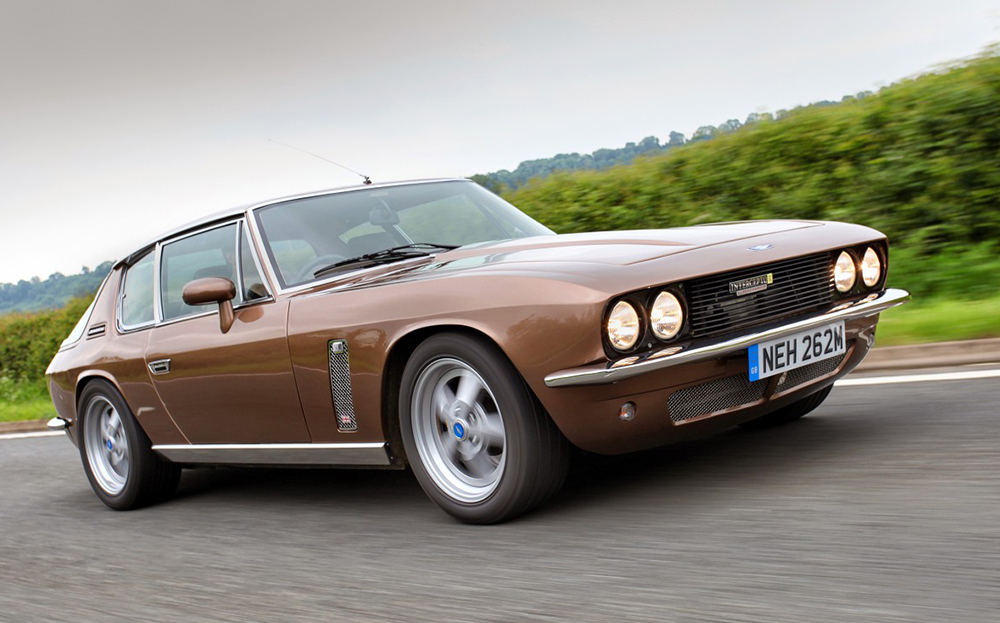You’ve heard of Jensen, right? Well maybe not, it’s another one of those tiny, ambitious British carmakers which originally began in 1934, building sports car bodies on Ford, Austin and Chrysler platforms.
Jensen Motors most adventurous project was the 1962 C-V8, based on a Chrysler platform, powered by a Chrysler V8 and designed by Eric Neale.
In 1965 the owners of Jensen Motors, brothers Alan and Richard Jensen decided that the C-V8’s successor needed a sleeker design, and rejected Neale’s proposal, instead turning to a number of Italian Carrozzeria, including Vignale and Touring of Milan.
Touring’s proposal was the successful design, but Touring was not geared up to manufacture large numbers of complete cars, so the small Vignale company, now based in Grugliasco outside Turin was selected to make the first cars.
It is at this point in the research that my attention was completely absorbed by the Vignale company. In 1948 Alfredo Vignale had started his car-making business in the unoccupied half of a sawmill in Turin's via Cigliano with his two brothers. They originally built bodies on a number of Fiat models, and the designs grabbed the attention of wealthy Italians who wanted something ‘different’ to the mass-produced cars.
 |
| Alfredo Vignale & Giovanni Michelotti (Photo: The Jensen Museum) |
The Jensen C-V8 body had been basically fibreglass, and one of the reasons the Jensen brothers chose Vignale is that the car that was to become the Interceptor would be built in steel.
After many years of producing metal-bodied cars for Ferrari, Vignale had earned a reputation for exquisite metal finishing, and high-quality interior trim.
 |
| 1953 Ferrari 250 Europa by Vignale |
The Jensen Interceptor was launched in 1966 to critical acclaim, with its powerful 6.3L Chrysler V8 providing outstanding power and torque. In 1967 Jensen took the entire manufacturing process in-house at its West Bromwich factory outside Birmingham.
That same year, Vignale made a bid to bring Interceptor production back to his larger Grugliasco works. He produced the Jensen Nova for the 1967 Geneva Salon, finished in a striking green paint job. The design had been ‘massaged’ by Michelotti, but the project was a gamble for Alfredo Vignale. Many of his former car manufacturer customers were taking their Vignale-produced cars back in-house. Times, and finances were getting tough to manage.
Just 30 motorised Interceptor chassis were delivered to Vignale, and almost immediately the production cars showed a number of quality problems, most notable was serious overheating.
In 1969 under a huge financial burden, Vignale was forced to sell his company, which was acquired by Alesandro de Tomaso. Sadly, just three days after the contracts were signed an exhausted Vignale was killed when his Vignale-bodied Fiat 1500 crashed into a power pole late at night.
In reality, Carrozzeria Vignale was a second-tier operation compared to companies like Pininfarina and Bertone – however, it’s a name and a brand still well-respected in the car world.
Alongside the RWD Interceptor the Jensen brothers created another adventurous project, the 4WD Jensen FF, which was the first 'car' ever to feature full-time 4WD, and Dunlop anti-lock brakes. However the car was too expensive, and strategically, poorly designed, because it could not be built in LHD. As Jensen's biggest market was the USA, the advanced FF denied the brothers the ability to add substantially to the company's revenues. Only 320 cars were ever produced.
Jensen continued on with the Interceptor until 1976, when the company was forced into receivership. In fact there was another problem which eventually forced the company to be wound up - a huge list of quality problems with the Jensen-Healeys resulting in big warranty cost blowouts.
Several attempts to revive the company and the brand happened in the 90s and as recently as early 2000, but all failed.
The total production of Interceptors was just 6408 cars over ten years between 1966-76.
I think Touring’s original design of the Interceptor was striking and completely original, and I’m even encouraged to place it alongside Cadillac’s new Celestiq sedan, which I think has all the same bold hallmarks with modern, edgy design cues.
JOHN CRAWFORD


.jpg)


.jpg)

No comments:
Post a Comment